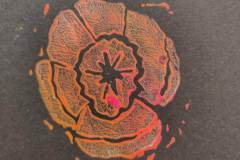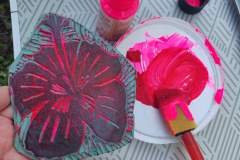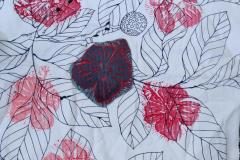
Bringing Ink and Printing Together
I’m excited to share the result of my creative process: combining inking and printing! I used acrylic paint and textile paint to apply ink in a thin, even coat to my designs. Then I printed on a variety of surfaces, including white paper, kraft paper, tissue paper, and fabric.
Block Print Goes Digital
To make my designs available in my asset library, I digitised them on my iPad. This allows me to have these assets accessible when I’m creating patterns and other works.
The Essential Tips for Printing Fabric
Printing fabric can be a tricky and time-consuming process. I learned a few essential tips that I would like to share.
Be Careful With the Paint
The key to successful fabric printing is to apply the paint in just the right amount. Too much and it will be too thick, too little and it won’t be visible.
Print On a Hard Surface
It is essential to print on a hard surface, such as a table or the floor. It is important to press down the block evenly for the best results.
Wash Everything Thoroughly
After printing, it is important to give everything a thorough wash – the blocks, tools, and even the fabric. This can be tedious, but it is an essential step.
My Secret Tip
My secret tip for getting the best results is to use your feet to press down the block when printing the fabric. This may seem unconventional, but it really does work!
Gallery
Block Printing: A Reusable Craft
Crafting with block prints is an easy and rewarding way to make your own prints. Not only is the material incredibly sturdy, but it is also incredibly reusable for a long time. I used to craft a lot with stencils, but they don’t last as long. The hard work of carving out the prints is worth it in the long run.
















